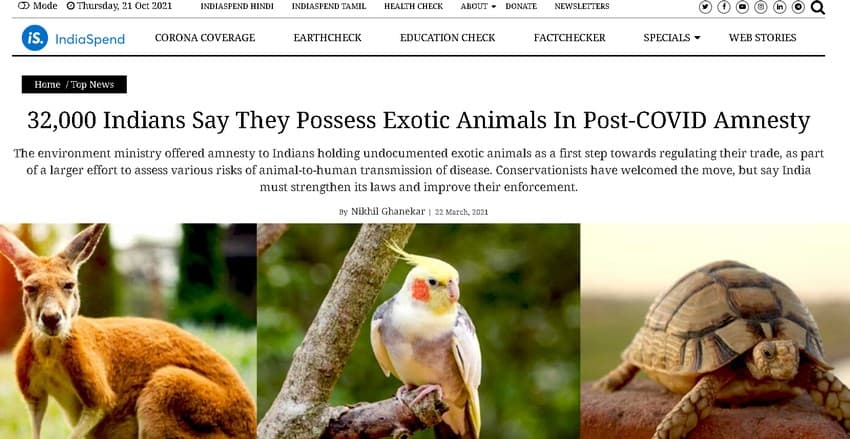Envisioning the Anatomy of a Potential Law to Regulate Trade in Exotic Animals in India
The lack of a mechanism to regulate trade in exotic animals in India is not in consonance with international conventions and has led to a booming trade in exotic species domestically. The exotic trade in wildlife not only impacts the biodiversity of the countries from which it is brought into India, but also poses serious risks to India’s indigenous species. We urgently need a strong law to deal with this double whammy that costs ecosystems in India and elsewhere.

Image is used for representational purposes. Photo credit: Guyon Moree/CC By 2.0
In June 2020, India’s Ministry of Environment, Forest and Climate Change (MoEF&CC) issued a voluntary disclosure scheme granting amnesty to those in possession of exotic live animals in India in a bid to comply with the requirements under the Convention on International Trade in Endangered Species of Wild Flora and Fauna1 (CITES). The response to this government issued advisory came as a rude awakening to the magnitude of trade in exotics in India. Applicants disclosed possession of 43,693 exotic animals as of May 2021 according to an RTI filed by Vidhi Centre for Legal Policy. Shockingly, the list included species such as the besia and black and white ruffed lemurs, all listed under Appendix I of CITES, in which commercial trade is banned.
Indian law does not regulate trade of exotic species within Indian borders. This means that while CITES permits are required for the import or export of species through Indian borders, there is no regulation whatsoever of trade, possession or breeding of these species domestically. The advisory was issued in an attempt to fill this legal vacuum. However, the amnesty granted by way of the advisory to individuals in possession of species listed in the CITES Appendix, irrespective of whether the animals have been smuggled into the country illegally, violates India’s commitments under CITES, which is a clear paradox. More importantly, however, the legal validity of an advisory to fill a legal vacuum is of serious concern, as it has not been issued under a parent legislation and is violative of international conventions. The advisory’s role and the concerns it poses have been discussed in depth here.
While creating an inventory of exotic species is necessary, at the same time, sound legal frameworks for regulating any future trade in such species is imperative. Without a sound regulatory mechanism, the advisory simply exonerates individuals from the charge of violating the existing legal regime under the Customs Act, 1962, and the Foreign Trade (Development and Regulation) Act, 1992, and does not adequately and effectively place restrictions on any further possession, trade or breeding of exotic animals in India. For instance, when the Wild Life (Protection) Act was enacted in 1972, it prescribed a six -month window within which individuals could declare their possession of scheduled species, and were issued a certificate of possession of the animal, its parts or products. Any subsequent, unauthorized possession of scheduled species upon the expiry of the six-month window was illegal. Unfortunately, there is no clarity on how possession of exotic live animals will be dealt with upon the expiry of the amnesty under the advisory, as it has not been issued within the ambit of any existing law. The MoEF&CC issued a draft amendment to the Wild Life (Protection) Act, 1972, made available in the public domain on October 23, 2021, that includes CITES within its ambit, but little can be gleaned as the amendment seeks to delegate powers of making rules to administer CITES related issues to the MoEF&CC.

Screengrab of the IndiaSpend report on the Indian government’s advisory.
The National Legislation Project under CITES lays down four minimum requirements to be met by parties. This includes the requirement to prohibit trade in specimens in violation of the Convention, penalise such trade, or confiscate specimens illegally traded or possessed. Indian law as it stands today provides for legal strictures for the import and export of exotic animals. However, the trade, possession and breeding of species within Indian borders remains completely unregulated, save for the advisory mentioned earlier. India is currently classified as a “Category 2” country as existing legislation is generally believed to not meet all the requirements for the implementation of CITES. India’s susceptibility to wildlife trade as a source and a demand country for wild fauna and flora has led to us being demarcated as a priority country that urgently needs to strengthen laws to fully implement CITES. Therefore, an amendment to domestic legislation to fully implement the requirements of the Convention is the need of the hour. However, this is no news to Indian policy makers as an attempt to incorporate CITES into domestic legislation was made in 2013 itself that did not see the light of day.
The 2013 amendment bill sought to include CITES appendices within the existing framework of the Wild Life (Protection) Act, 1972. It did so by introducing an additional chapter and Schedule to the Act which regulated and prohibited the trade, possession, and breeding of CITES listed species in fulfilment of India’s obligations under the Convention. Unfortunately, however, this amendment bill was withdrawn by the MoEF&CC in December 2014, while it was with the Parliamentary Standing Committee on Science, Technology, Environment and Forests for their inputs. The amendment bill of 2013, if passed, would have created a robust framework for implementation of CITES in India. It addressed key concerns including placing restrictions on possession, trade and breeding of exotic species within India.
A fresh amendment bill was sent to the Secretaries of various State Government and Union Territories for their comments early in October 2021 and was put in the public domain on October 23, 2021. The draft amendment seeks to bring CITES within the ambit of the Wild Life (Protection) Act, 1972. The amendment delegates the power to make rules pertaining to the implementation of the convention to the MoEF&CC and provides the broad strokes for what the rules must contain. It mentions that the possession of CITES listed species shall be illegal without the prior permission of the Chief Wildlife Warden. It also extends the powers of search, seizure and arrest granted to Forest Department and police officers to enforce the convention as well. However, delegating the implementation of the convention to the Ministry causes important details of implementation of an international convention to escape parliamentary scrutiny.
Some of the features that could potentially provide for smooth and seamless implementation of CITES in India are discussed in some detail below:
Prohibitions and Regulation of Trade
CITES recommends that national legislation as a whole should regulate all aspects of international wildlife trade, including harvesting or production, keeping, modification, sale, transport, use and disposal of species. In the Indian context, additional prohibitions on the release of exotic animals into the wild, prohibitions or regulation of domestic trade and a fool proof mechanism to ensure that animals are transported and kept in hygienic conditions to prevent the outbreak of zoonotic disease are essential.
Enabling an inter-agency approach
CITES also recommends that any domestic legislation must clearly demarcate departments and agencies responsible for enforcing the Convention and grant powers to enforcement agents to execute their tasks. These powers typically include those of search and seizure, arrest, to inspect documents and take samples of specimens for identification purposes. These powers extend to filing offence reports before courts, conducting an investigation on the case and, in the case of India’s Wildlife Act, the power to record confession statements.
The recognition that wildlife trade is a transboundary crime also means that it takes for a strong inter-agency approach to detect, investigate and prosecute it. The National Crime Records Bureau’s annual reports show that several cases instituted against wildlife traffickers have been an outcome of a collaborative approach between paramilitary forces such as the Assam Rifles, Sashastra Seema Bal (SSB), Border Security Forces (BSF), Customs, Police and the Forest Departments. Authorizing multiple agencies to detect, detain, search and arrest suspects would allay some of the current inadequacies in existing wildlife law.
Punishments Prescribed
A critical aspect of any law is the punishment prescribed for commission of an offence. Wildlife trafficking is considered an organised crime with several players involved – ranging from communities that may be involved in procuring specimens for trade, to financiers and transporters that may be in the business of import and export of species across the country or across international borders. The treatment of these individuals based on the severity of their involvement is imperative to ensure equity in the justice system. In the current legal framework, traders as well as those who may hunt for subsistence face the same punishment based on the schedule of the species involved in the crime, and not on the severity of the crime itself. The prescription of maximum and minimum punishments, for trade in native and exotic species, must be revisited after detailed consultation with criminologists who may suggest a more effective method of dealing with punishments for wildlife trade.
Manpower, Detection and Prosecutorial Capacity
While one may recommend that the law facilitates an inter-agency approach to countering the menace of illegal wildlife trade, this is impossible to execute without enhanced capacity on our frontlines and a better work environment. Overburdened staff with multifarious responsibilities, meagre pay, and inadequate training contribute to an overworked and demotivated workforce. While we may call for an amendment to the law, addressing concerns of an overworked frontline force that is committed to fighting wildlife crime is a necessary catalyst to ensure better implementation of the law. This is also true of the lower judiciary that deals first-hand with cases of wildlife trade but are often overburdened and unfamiliar with the existing legal framework. This may particularly be so as they grapple with numerous cases of a large variety – making those related to wildlife cases an anomaly amongst the plethora of laws they deal with.
A lose-lose situation – Invasives
The trade in exotics affects multiple natural habitats – it takes away an important cog in the wheel of the ecosystem from which the animal is sourced. At the same time, these animals pose the threat of becoming invasive in an ecosystem to which they do not belong. This may also be the case with animals that are not listed on the CITES appendices. Concerns with invasives entering our wild spaces have already found root in India, as can specially be seen with fauna such as the red-eared slider, a favourite pet and a native to the Mississippi and the Gulf of Mexico. These turtles are often released into water bodies, posing a significant threat to India’s freshwater habitats. The proposed amendment of 2021 provides a framework for dealing with invasive species more emphatically whether or not they are listed on the Schedules.

Exploding demand and the wide-spread trade in red-eared sliders for the pet market has led this turtle species to emerge as an invasive of serious concern in countries it has been introduced in, including India. Image used for representational purposes. Photo courtesy: pxfuel.com/public domain
Deeper Research and the Need for a Consultative Process
The legislative process is a consultative one, and it mandates the government to work with citizenry and experts to put together legal frameworks to address amendments to any law. The complexity of the trade in exotics, questions of whether regulation of trade in exotics is better than a ban on the same, conformity with CITES and appropriate punishments for violation of the law are highly sophisticated questions, often with no straight answers. These require various experts to provide a nuanced, fool proof mechanism to regulate trade within India. These include economists, criminologists, sociologists, biologists and international law experts amongst others. Further, a deeper study of mechanisms for the effective implementation of CITES in other countries may contribute towards ensuring a strong framework in India as well. The amendment of 2021 is yet to be placed before the public at large for their comments as it is mandated to do according to the Pre-Legislative Consultation Policy.
The magnitude of the trade in exotics in India leaves little doubt as to the urgency of addressing the existing legal vacuum. The pandemic has been a horrific reminder of the threats of zoonotic disease, often propelled by the conditions in which animals may be transported, kept or sold. India boasts of strong legal frameworks for environmental conservation instated since the 1970s; this is an opportunity for us to renew and strengthen our commitment to conservation as a country.
1 CITES is a multilateral treaty entered into by 183 countries with the intent of ensuring that the global trade in wildlife does not threaten the survival of species. The Convention was ratified by India in 1976. It regulates the global trade in wild flora and fauna.
Read other articles in the series:
- India’s Growing Fetish for Wildlife Of The Exotic Kind
- Why India Needs Stronger Laws to Protect Exotic Species on its Soil
- India’s Burning Exotic Pet Trade Crisis
- Forced to Pay the Ultimate Price for the Pet Trade
——————————————————————————————————————————————————————
About the author: Mridula is an environmental lawyer who is passionate about law surrounding wildlife conservation and large development projects. She previously practiced as an independent lawyer, representing clients against large development projects before various courts, and subsequently led the legal team at Wildlife Conservation Society – India. At WCS-India, she worked largely on law and policy surrounding wildlife trade and its implementation in close collaboration with government departments and agencies.
Disclaimer: The views and opinions expressed in the article are the author’s own and do not necessarily reflect the views and opinions of the Wildlife Conservation Trust.
——————————————————————————————————————————————————————
Your donations support our on-ground operations, helping us meet our conservation goals.
——————————————————————————————————————————————————————

